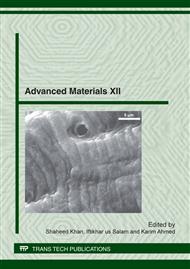p.507
p.513
p.520
p.527
p.532
p.540
p.547
p.554
p.560
Effect of Carbon Black on Curing Behavior, Mechanical Properties and Viscoelastic Behavior of Natural Sponge Rubber-Based Nano-Composites
Abstract:
Natural rubber (polymer designation cis-1-4 polyisoprene, is obtained from the sap ("latex") of several rubber-yielding plants (e.g., HeveaBrasiliensis and Partheniaargentatum) by coagulation with chemicals, drying, electrical coagulation, and other processes. Foamy or sponge structure of natural rubber (NR) is very useful in aerospace and as auxetic materials (exhibiting negative poisons ratio) for use in application of homeland security.The main aim of this research to estimate the influence of carbon black on mechanical properties, curing and viscosity variation behaviors of the natural rubber based composites. Different amounts of carbon black were used along with other fillers. The influence of carbon black on curing behavior and mechanicalproperties of natural rubber foams was investigated at different feedingratios of the carbon black. The physical properties of the foamed NRs were then measured as a function of carbon blacks content. The mechanical properties of the foamed NRs such as tensile strength,strength at break and modulus,were gradually increased with increasingcarbon black content whereas elongation decreasedat break.
Info:
Periodical:
Pages:
532-539
Citation:
Online since:
May 2012
Authors:
Price:
Сopyright:
© 2012 Trans Tech Publications Ltd. All Rights Reserved
Share:
Citation:


